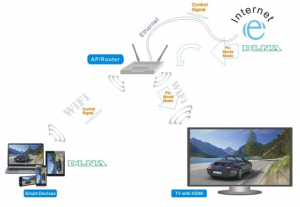Most consumers prefer integrated solutions. A gadget that does everything and the more the merrier. I think that most of the time, you can get a better solution if you integrate top-of-category components yourself. Especially if, like me, you love technology and are not afraid of integrating.
A few months ago, when I was shopping for a new TV, I was bombarded by the assortment of models on the market. The newer models were often twice as expensive as older ones, while the main difference between the newer and the older models was what I call “smart TV” functionality. “Smart” TV is a marketing term for “computer-like” or “streamer-like” functionality in a TV. This could include playing videos from a LAN, or the Internet or using the TV as a browser.
I was quite put off by this “bundle”. For me, since the era of cable and satellite TV, a TV is just a monitor, just a surface with pixels. For me it didn’t make sense to bundle a limited browser or streamer functionality in a TV. Those are just new features for the TV manufacturer to justify a new line of TVs with. Having this un-bundled allows you to get a device that is best in class (if you want) for each component and not get the limited one you normally get bundled in. Separate devices let you upgrade each of the components in the future without changing the other.
Eventually I went for a model without such functionality, saving a significant amount of money. Typically that would mean that you will get a separate streamer of your choice, however, in this case I didn’t even need that. The model I chose had something called DLNA. I didn’t know what this was, so I was surprised after reading some material about this online.
In a nutshell, DLNA is a standard that defines how media can be transmitted in a network (LAN) between devices. Some devices produce media, some consume media and some just manage the process. Reading about this, I saw that I already have all the needed devices available and no additional components were needed.
So, here is the configuration I ended up with:
- Ethernet LAN (gigabit). I am a big fan of the Tp-Link WR1043ND router and its support for dd-wrt.
- One DLNA supporting LG TV, just plug in an Ethernet cable.
- One LG TV with HDMI only, adding DLNA support with a Wifi based DLNA->HDMI dongle. Less than 40$ on aliexpress.
- Serviio media streaming server to index and stream your media on the PC. I choose Serviio because it can also stream YouTube channels. Other options are available.
- Android devices with BubbleUPnP for control and using the SmartPhone for rendering.
- Samsung Android devices with AllShare (Samsung Link) to stream media from SmartPhones.
In the end, I enjoy this configuration a lot for streaming media to the TV. It is a great alternative to adding streamers or settling on a built-in “smart TV” functionality. However, as much as I love this, there is still a lot to wish for if one wants to use it as an alternative to having a PC connected to the TV via HDMI. A PC just gives you unlimited flexibility, which you will sometimes need. So choose your setup to meet your requirements.

I completely agree about the motivation to separate the screen from the streamer. There’s now a similar trend to stick some graphical processing in the audio amplifier, and I don’t see what the consumer gains from this.
But I think DLNA is just an interface for transferring (compressed) files. You’ve actually got a streamer, in that dongle.
BTW, note that most TV’s I’ve seen don’t support gigabit ethernet. I use cables at home for robustness/speed, but gigabit isn’t an option.